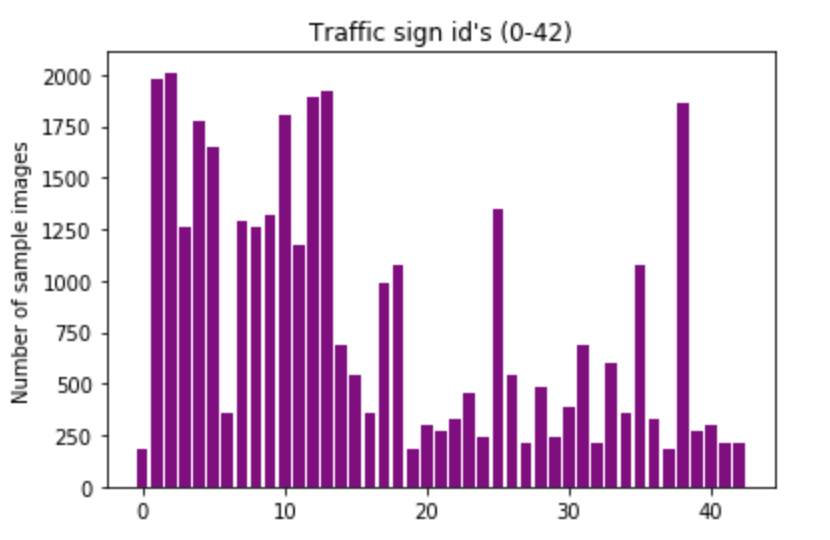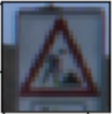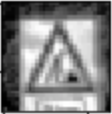Implements Traffic Sign Recognition for the German traffic signs using a lenet based neural network
The goals / steps of this project are the following:
- Load the data set (see below for links to the project data set)
- Explore, summarize and visualize the data set
- Design, train and test a model architecture
- Use the model to make predictions on new images
- Analyze the softmax probabilities of the new images
- Summarize the results with a written report
1. Provide a basic summary of the data set. In the code, the analysis should be done using python, numpy and/or pandas methods rather than hardcoding results manually.
I used the numpy library to calculate summary statistics of the traffic signs data set mainly using the .shape method:
- The size of training set is 34799
- The size of the validation set is 4410
- The size of test set is 12630
- The shape of a traffic sign image is (Height, Width, Channels) = (32, 32, 3)
- The number of unique classes/labels in the data set is 43
Here is an exploratory visualization of the data set. It is a bar chart showing the number of sample images that correspond to each of the traffic signs. We can conclude that there is great variability on the number of samples between the different traffic signs ranging from the order of 100 to 2000 samples.
1. Describe how you preprocessed the image data. What techniques were chosen and why did you choose these techniques? Consider including images showing the output of each preprocessing technique. Pre-processing refers to techniques such as converting to grayscale, normalization, etc. (OPTIONAL: As described in the "Stand Out Suggestions" part of the rubric, if you generated additional data for training, describe why you decided to generate additional data, how you generated the data, and provide example images of the additional data. Then describe the characteristics of the augmented training set like number of images in the set, number of images for each class, etc.)
As a first step, I decided to convert the images to grayscale because we can get their classification by only looking at their shapes. The validation accuracy improved by 0.03 using the Lenet-5 model with only adding grayscale preprocessing.
As a following step I applied histogram equalization to better distribute the pixel color values through out the [0, 255] range. The validation accuracy improved by another 0.025 using the Lenet-5 standard model.
As a last step, I normalized the image data because it is a good technique to have zero variance and zero mean. I have chosen to normalize the grayscale channel values from [0, 255] to [-0.5, 0.5]. This added to the validation accuracy by another 0.05 and was the most contributing preprocessing step to the network prediction accuracy improvement.
After all applying all the preprocessing steps and without any change in the standard Lenet-5 model, the validation accuracy jumped from 0.83 to 0.932, i.e. by a factor of 0.1!
Here is an example of a traffic sign image before and after preprocessing
2. Describe what your final model architecture looks like including model type, layers, layer sizes, connectivity, etc.) Consider including a diagram and/or table describing the final model.
My final model consisted of the following layers based on the Lenet-5 standard model. My modification is the addition of dropout layers after the activation functions of the fully connected layers.
| Layer | Description |
|---|---|
| Input | 32x32x1 grayscale and preprocessed images |
| Convolution | 1x1 stride, valid padding, outputs 28x28x6 |
| ReLU | |
| Max pooling | 2x2 stride, valid padding, outputs 14x14x6 |
| Convolution | 1x1 stride, valid padding, output 10x10x16 |
| ReLU | |
| Max pooling | 2x2 stride, valid padding, outputs 5x5x16 |
| Flatten | Outputs 400 |
| Fully connected | Outputs 120 |
| ReLU | |
| Dropout | Keep prob 0.65 |
| Fully connected | Outputs 84 |
| ReLU | |
| Dropout | Keep prob 0.65 |
| Fully connected | Outputs 43 |
3. Describe how you trained your model. The discussion can include the type of optimizer, the batch size, number of epochs and any hyperparameters such as learning rate.
To train the model, I used the Tensorflow adamOptimizer, after doing some experiments with the adagardOptimizer as well. I have trained the network on my mac book pro 2,5 GHz Intel Core i7 processor and took approximatelly 5.4 minutes. I used a batch size of 128 since I did not encounter any delays from my cpu. I trained the network for 30 epochs with a learning rate of 0.000989 to minimize overfitting once again.
4. Describe the approach taken for finding a solution and getting the validation set accuracy to be at least 0.93. Include in the discussion the results on the training, validation and test sets and where in the code these were calculated. Your approach may have been an iterative process, in which case, outline the steps you took to get to the final solution and why you chose those steps. Perhaps your solution involved an already well known implementation or architecture. In this case, discuss why you think the architecture is suitable for the current problem.
My final model results were:
- training set accuracy of 0.997
- validation set accuracy of 0.962
- test set accuracy of 0.935
An iterative approach was chosen:
- The first architecture that has been tested was the LeNet-5 architecture.
- The problem with this architecture was that the max validation accuracy was 0.93.
- The architecture was adjusted so a dropout layer was added after the activations of the first and second fully connected layers in order to reduce the overfitting issue.
- The keep probability of the dropout layers was tested for settings varying from 0.5 to 0.7, and a design decision was made to go with a keep probability of 0.65 that achieved the best validation accuracy from the other values. The dropout layers increased the validation accuracy by a factor of 0.01.
- The final model's accuracy on the training, validation and test set provide evidence that the model is working above the 0.93 project requirement.
1. Choose five German traffic signs found on the web and provide them in the report. For each image, discuss what quality or qualities might be difficult to classify.
Here are five German traffic signs that I found on the web:
The stop sign should be the easiest to classify since it has a unique outer shape, that of a hexagon. The same is expected for the priority road sign that has the outer shape of a rhombus. The 60 Km/hr speed limit although it has the common circle shape has the 6 as a unique number, it is expected to be a little more difficult to classify than the two previous signs. The no passing sign is expected to be more difficult as the grayscale conversion might confuse the classifier with other traffic signs such as clear to pass. The general caution sign is expected to be easily classified since it is has both a trianglar shape and a semicolon that easily stands out.
2. Discuss the model's predictions on these new traffic signs and compare the results to predicting on the test set. At a minimum, discuss what the predictions were, the accuracy on these new predictions, and compare the accuracy to the accuracy on the test set (OPTIONAL: Discuss the results in more detail as described in the "Stand Out Suggestions" part of the rubric).
Here are the results of the prediction:
| Image | Prediction |
|---|---|
| Stop Sign | Stop sign |
| Speed limit 60 km/h | Speed limit 60 km/h |
| Priority road | Priority road |
| No passing | No passing |
| General caution | General caution |
The model was able to correctly guess 5 out of the 5 traffic signs, which gives an accuracy of 100%. This compares favorably to the accuracy on the test set of 0.935
3. Describe how certain the model is when predicting on each of the five new images by looking at the softmax probabilities for each prediction. Provide the top 5 softmax probabilities for each image along with the sign type of each probability. (OPTIONAL: as described in the "Stand Out Suggestions" part of the rubric, visualizations can also be provided such as bar charts)
The code for making predictions on my final model is located in the 15, 16, and 17 cells of the Ipython notebook.
For all the images, the model is almost certain sure aboout the corresponding sign (probabilities of 0.996 to 0.999). The top five soft max probabilities were
| Probability | Prediction |
|---|---|
| .999 | Stop sign |
| .996 | Speed limit 60 km/h |
| .999 | Priority road |
| .999 | No passing |
| .999 | General caution |







